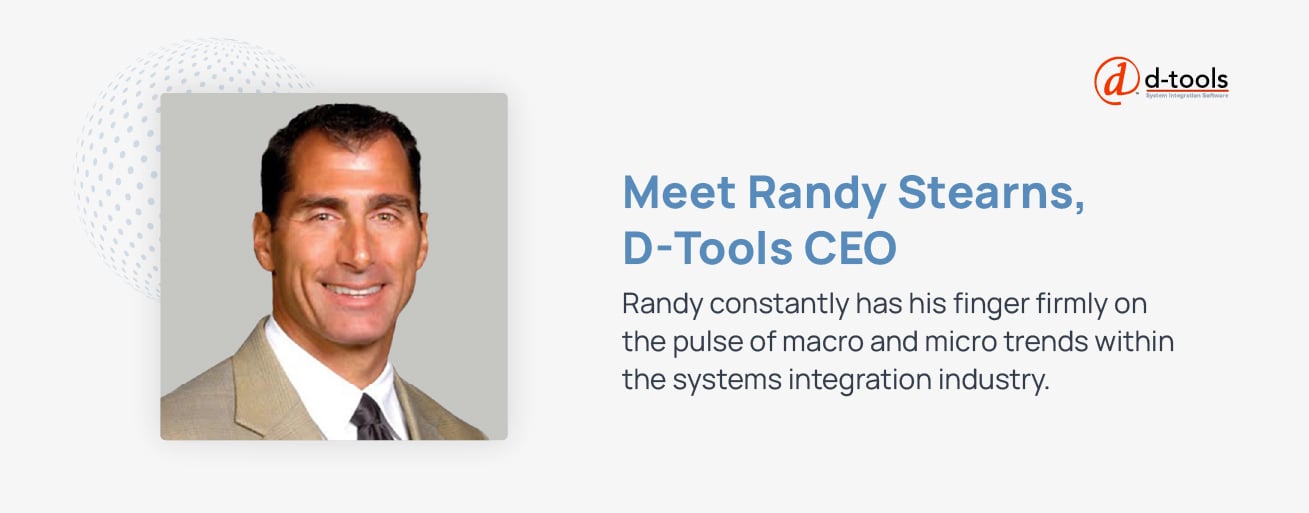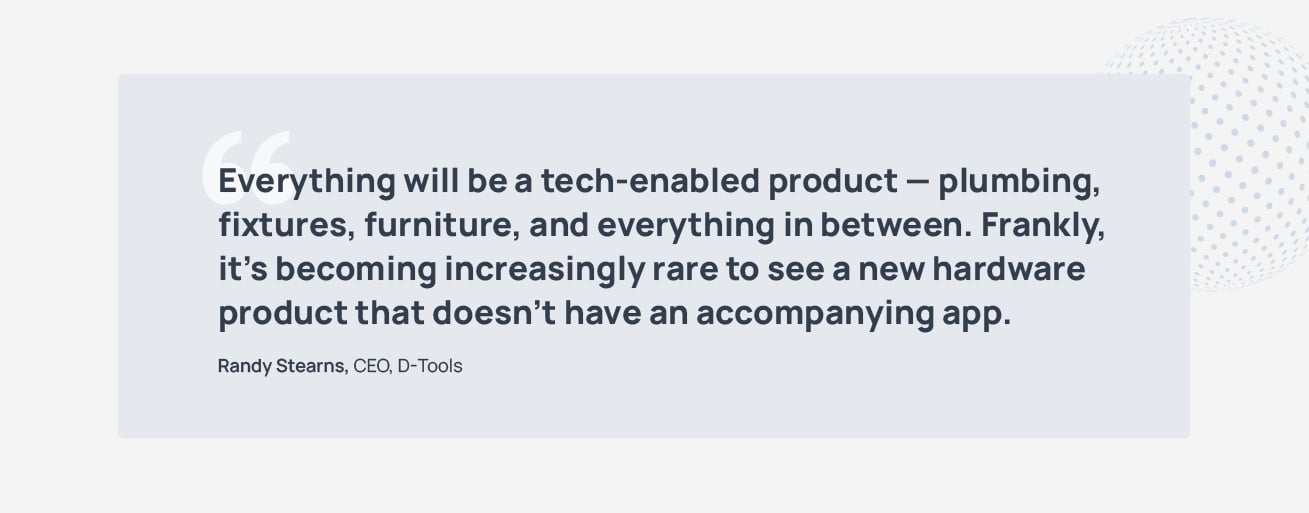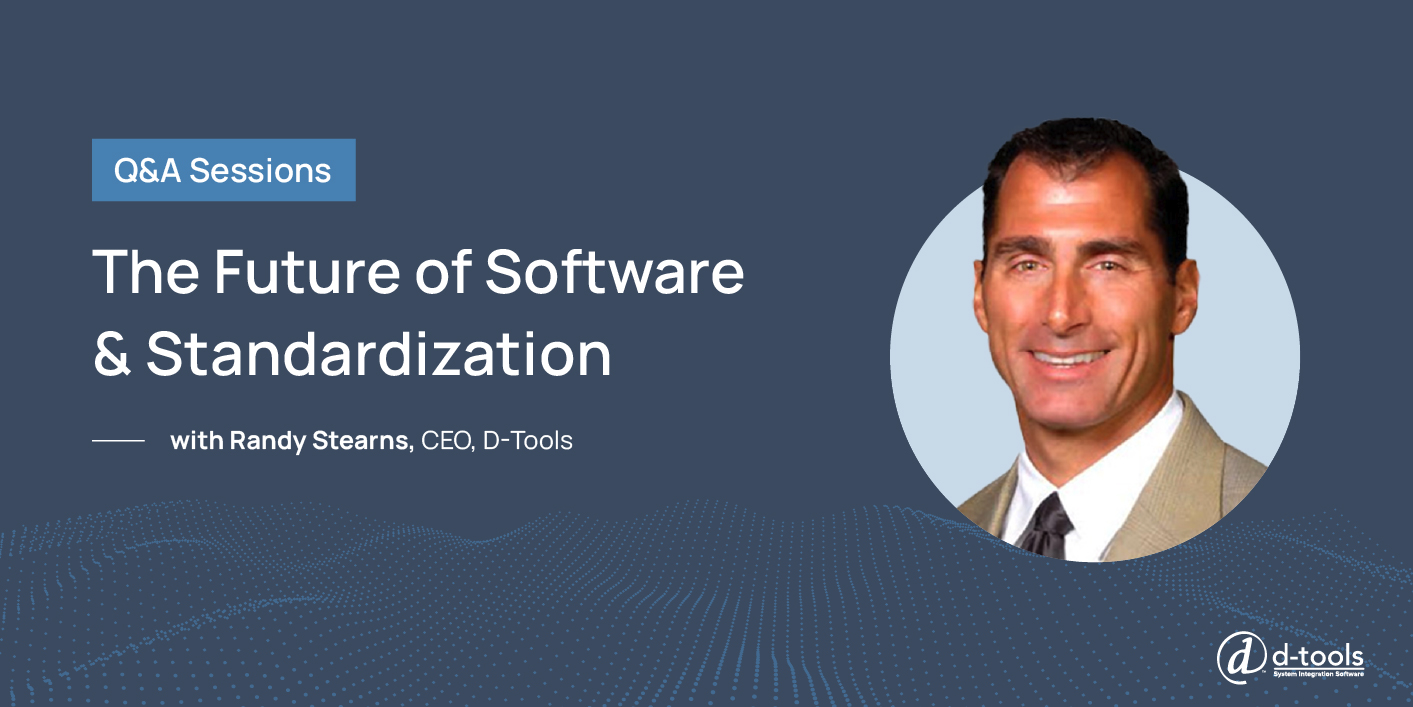As CEO of D-Tools, Randy Stearns has his finger firmly on the pulse of macro and micro trends within the systems integration industry.
Prior to joining the D-Tools team, he founded Engineered Environments, one of the nation’s largest and best reputed custom residential systems integration firms. He subsequently led an industry consolidation that merged Engineered Environments with six other industry leaders to form VIA International, Inc.
Through 2014, Randy acted as CEO of VIA which operates in eight states with 350 employees and $70M+ in revenues.
We recently sat down with Randy to hear about his career journey, his time as Chairman at CEDIA (the Custom Electronic Design and Installation Association), his supreme confidence in D-Tools software, and his expectations for the industry’s future.

Can you tell us a bit about your professional background and journey to D-Tools?
Sure thing. I’ve spent the bulk of my career in the business of residential electronic systems contracting.
Prior to business school I worked in technology sales, and after earning my MBA, I worked for a systems integrator. That was essentially an apprenticeship, where I learned as much as I could before striking out on my own.
Two years later, I built a company that eventually became one of the largest residential systems integration firms in the country — Engineered Environments — with about one hundred employees and offices in San Francisco, Hawaii, Lake Tahoe, and the Houston area.
Despite our size, we maintained a very targeted focus: to provide state-of-the-art systems for ultra high net-worth clients.
What was the typical project scope for that clientele?
Given the sophistication of these systems, projects ranged anywhere between a quarter of a million to four million dollars.
Did those projects put you on the map with CEDIA?
Actually, I had already been very active with CEDIA at that point. They knew I had earned an Ivy League degree and an MBA, and before long, they asked me to help teach their business courses.
I became the head of the CEDIA business curriculum, and from there, joined their Board of Directors. Eventually, after holding all of the executive positions over a period of about eight years, I became Chairman.
More than anything else, that experience introduced me to a ton of great people across the industry.
Fast forwarding to today, what would you say are the primary challenges facing the industry in 2022?
Honestly, our past challenges remain our present challenges. History seems to be repeating itself.
In other words, our industry always struggles to keep up with the latest technology advancements. It’s certainly a good problem to have, but it’s also a bit Sisyphean.
There’s also the ongoing challenge of successfully managing a team of employees and making sure they’re working at 100% efficiency.
And even if employees are performing at peak potential, there are field-related issues that inevitably interfere. In some cases, that means figuring out how our contractors can interface with other trades. Other times, it means overcoming scope creep — a seemingly existential problem in our industry.
Does the labor shortage factor in here?
Oh yeah, in a big way. To be honest, the aforementioned challenges kind of fade into the distance before bigger threats like the labor shortage.
People often point to supply chain issues as our archenemy, but in my opinion, that will likely dissipate over the next six-to-twelve months.
The labor shortage is more concerning, because unlike supply chain issues, this is unlikely to be resolved in the near future.
To that end, we’ve been very vocal about how companies can neutralize the labor shortage by improving employee engagement, establishing best practices, and exploiting productive tools.
How does software play a role in this?
In my opinion, software is essential to increasing employee output and project throughput.
Once best practices are developed, software can do an amazing job enforcing and automating those processes.
But here’s the thing: in order for software to live up to its potential, you have to fully commit to it. It’s like a marriage.
Many system integrators have invested in industry-specific software solutions, but few leverage the full power of these tools. As a result, productivity gains may only be marginal.
Organizations that have taken the time to understand the software’s capabilities, set it up optimally, train their staff fully, and implement across the organization will tell you that it’s the best business decision they have ever made.
The productivity gains they’ve experienced are enormous.
To put it another way, if you can increase staff performance and project success by 20-30%, you’ll likely overcome the need to keep hiring (at least for a period of time).
What about supply chain issues? Can software help relieve those pain points?
Yes, I believe standardization is the best defense against supply chain issues.
For example, our products allow you to establish project templates — which are essentially sets of tasks, subtasks, and checklists. These items enable integrators to follow a customized workflow and get the job done on time.
But here’s the catch: if the integrator incorporates the long lead-time items into their workflow — and prioritizes ordering earlier in the process than they otherwise would — they beat the game. They overcome supply chain hurdles.
So while they can’t physically get cargo ships to coastlines any faster, integrators can use our software to stay on schedule and avoid missing deadlines that often stem from product delays.
These same benefits extend to companies looking to standardize on specific products.
Do you mean in terms of inventory management?
Right. If a company integrates with our inventory management solutions, they can easily see what’s in stock.
Within that framework, they can set “minimum levels” for products that typically take a while to receive and thereby eliminate extant variables.
It’s funny, because this sort of practice should be the industry standard. But generally speaking, people — and businesses, for that matter — only adapt when they’re forced to.
In a way, the supply chain issues are compelling everyone to build better businesses. We’re creating standards and consistencies and planning ahead in a way that benefits everyone from the customer all the way to the CEO.
It’s a win-win.

You mentioned the speed of technological advancements earlier. Where do you see the residential AV landscape evolving over the coming years?
As a general trend, I believe the industry will continue moving away from proprietary solutions and towards open architecture, open source products.
There’s a fundamental reason for this: because the consumer is asking for it and expects it.
Everything will be a tech-enabled product — plumbing, fixtures, furniture, and everything in between. Frankly, it’s becoming increasingly rare to see a new hardware product that doesn’t have an accompanying app.
Control, convenience, and accessibility remain dominant categories, and within them, things like voice control and AI are proliferating through almost every domestic product.
On that note, how has the pandemic influenced the industry?
Well, the home is more valued — and valuable — than ever.
Hybrid work and learning environments are truly ingrained in our culture, and people expect their homes to reflect and facilitate that reality.
For example, some families want more than a flatscreen in their game room — they want a SMART board, something their kids can write on and interact with.
There’s also a big push towards health — cultivating healthier living solutions that promote better air quality, human-centric lighting, and mattresses that track your temperature and sleep patterns.
And in addition to wearable technologies, there are even toilets that provide a detailed report on your bodily output.
Here I was thinking we’d talk mostly about home theaters…
Hey, residential AV is far more expansive than it used to be, and the constellation of modern technology is rapidly expanding.
Ultimately, we’re really excited to see our products help facilitate these emerging trends.
>> Learn more about the D-Tools System Integrator (SI) solution here.





